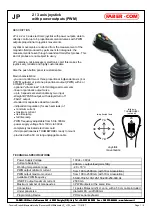
L-VIS User Manual
191
LOYTEC
Version 6.2
LOYTEC electronics GmbH
Based on the NV the data point is derived from, the following kinds of data points are
created:
Simple NVs that hold only one scalar value, e.g., SNVT_amp: Those kinds on
NVs are represented as analog data points. The data points holds the current
value, NV scaling factors are applied.
Simple NVs based on an enumeration, e.g., SNVT_date_day: Enumeration types
result in multi-state data points. They represent the state of the NV.
Structured NVs that consists of a number of fields, e.g., SNVT_switch: All
structured NVs are represented as user point. That is, the data point is structured
similar to the NV it is based on. Beneath the user data point, the individual
structure fields are presented as child data points.
10.4.2 CEA-709 Schedulers
CEA-709 schedulers and the CEA-709 calendar adhere to the L
ON
M
ARK
standard objects.
For CEA-709, certain restrictions exist that need to be kept in mind. Attached data points
can either represent an entire NV or individual elements of a structured NV. CEA-709
schedulers may have several different data points attached, i.e., the value preset may consist
of more than one element. For example, a CEA-709 scheduler might schedule a
SNVT_temp and a SNVT_switch and have 3 elements in each value preset as depicted in
Figure 9. To control similar data points synchronously, they may be added to the same
group to share the same value preset.
Figure 9: Example value presets in CEA-709 schedulers.
Priorities of exception days in a CEA-709 scheduler range from 0 (the highest) to 126 (the
lowest). The value 127 is reserved as a default for weekdays.
Further, the implementation as L
ON
M
ARK
standard objects requires the use of configuration
properties. If the number of CEA-709 schedulers or their capacities for daily schedules and
value presets is changed, the resource and static interface of the CEA-709 port changes.
The resources reserved for L
ON
M
ARK
calendar and scheduler objects can be changed in the
network settings (see section 10.10.10). When downloading a project, the software verifies
if sufficient resources have been configured. If it detects a problem, the user is notified to
update the resource allocation as needed.
NOTE:
The Auto-Set button adjusts the resources such that the currently known configuration will
fit. Any additional resources required to add more schedules during runtime need to be
considered and added manually to the automatically determined values.
10.4.3 CEA-709 Alarming
Local CEA-709 alarming supports only one alarm server object. This alarm server object is
represented by the device’s L
ON
M
ARK
node object and facilitates the SNVT_alarm2 output
network variable. Acknowledging alarms in the alarm server is adhering to the L
ON
M
ARK
specification and relies on the RQ_CLEAR_ALARM mechanism.
10.4.4 CEA-709 Trend Logs
Due to the absence of a common standard for trend data transfer over CEA-709 networks,
there is currently no implementation of a CEA-709 trend object available. CEA-709 devices
like the LVIS-3E100, 3E112, and 3E115 use generic trends and expose them via OPC only.
















































